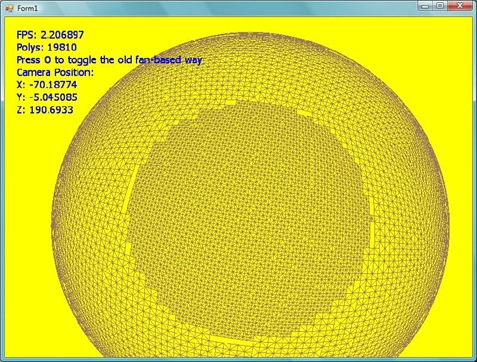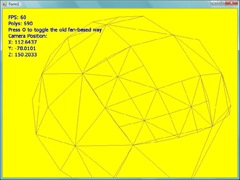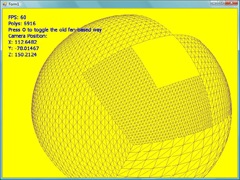I was avoiding doing this for so long, but in the end it's a really simple solution. It's a familiar problem, quad trees are great and all but they are really slow when you're trying to render a high detail (well at least the way I implemented them). Each quad has 9 vertices and renders by drawing a fan. Previously I had given each quad its vertex and index buffer and this was a nightmare to clean up on program exit, it would just take AGES! I only found this out but it's no big hit to just share a vertex and index buffer between loads of patches just set the needed data before each render - the clean up is almost instant. So here's what a geomipmapped quad tree at level 8 looks like:
It's only about 20,000 polygons but it's rendering at only 2 FPS, so unless I include sloths in my game demographic I'll have to improve on the speed. I thought the main problem stems from the fact that I'm doing about 2,500 renders of only 8 polygons in a fan and that it would be a lot faster as a triangle strip. I tried to think of algorithmic ways of aggregating all the vertices in a quad and rendering as a triangle strip - when blood started coming out of my ears I decided there must be a simpler way. So in the end the solution was a combination of (what I call) CLOD and quad trees - basically each quad tree patch can draw way more than just the 3 x 3 vertices in a fan, let each patch draw a triangle strip of (say) 17 x 17 vertices. This way I can reduce the levels needed to render a planet in high detail. Hopefully the next images will make this obvious:
In the first image on the left I'm showing (with holes) the old way, a really low detail quad tree, and each quad patch draws a fan. With the new way shown in the image on the right, the quad tree has the same number of levels as in the previous image but each quad patch draws a 17 x 17 grid. The result is that the planet has a much higher level of detail, but the quad tree doesn't.
The trade-off is that the polys aren't culled as accurately as before but that's nothing compared to the gain in FPS (back up to 60 again) for reasonable detail. I'll need to fix holes, cracks and level of detail calculations next, all old news...



No comments:
Post a Comment